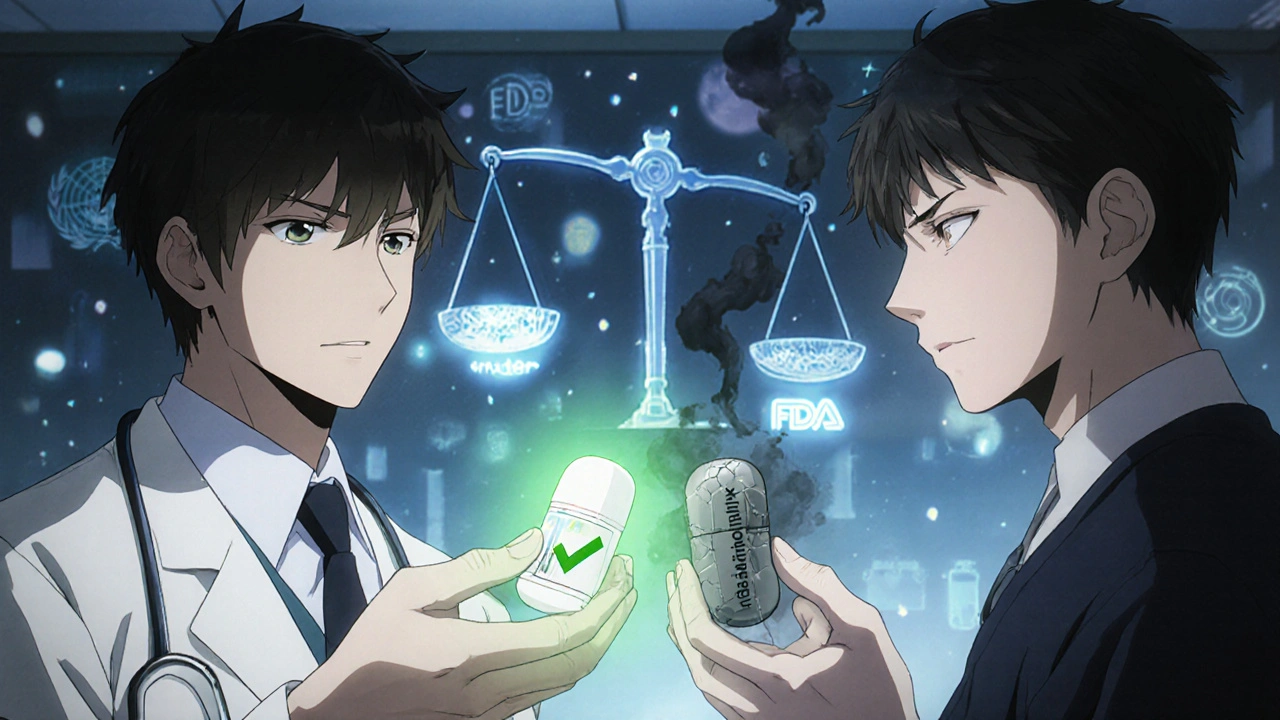Combination Drug Suitability Calculator
Find out if a combination drug is right for you
This tool helps you assess the potential benefits and risks of fixed-dose combination (FDC) drugs based on your medical situation.
1. Select your conditions
2. How many medications are you currently taking?
3. Any contraindications or special considerations?
When you’re managing multiple health conditions, popping five or six pills a day isn’t just inconvenient-it’s exhausting. That’s why combination drugs, or fixed-dose combinations (FDCs), became so popular. Instead of separate tablets for blood pressure, cholesterol, and diabetes, you get one pill that does it all. Sounds simple, right? But behind that convenience lies a complex trade-off: fewer pills may mean better adherence, but mixing ingredients can also mean hidden risks you didn’t sign up for.
Why Combination Drugs Became So Common
Combination drugs aren’t new. Ancient medicine systems like Traditional Chinese Medicine used plant mixtures for centuries. But modern FDCs took off in the 1970s with drugs like sulfamethoxazole and trimethoprim, which together fight bacterial infections better than either alone. Today, they’re used for everything from tuberculosis to heart disease to Parkinson’s.The World Health Organization has recognized their value since at least 2005, listing 18 fixed-dose combinations in its Essential Medicines List. Why? Because they work. For patients in low-resource areas, a single pill that treats TB with rifampicin and isoniazid means better compliance and higher cure rates. For someone with hypertension, a low-dose combo of an ACE inhibitor and a diuretic can control blood pressure more effectively than either drug alone.
Studies show that when people take fewer pills, they’re more likely to stick with their treatment. One study found that patients on combination therapy were 20% more likely to stay on track than those taking separate medications. That’s huge-non-adherence is one of the biggest reasons treatments fail.
How Combination Drugs Actually Work
Not all combinations are created equal. A good FDC isn’t just two drugs shoved into one capsule. It’s a carefully designed partnership. The ingredients need to:- Work through different biological pathways
- Have similar absorption and elimination rates in the body
- Not amplify each other’s side effects
For example, levodopa and carbidopa are paired because carbidopa blocks the breakdown of levodopa in the bloodstream, letting more of it reach the brain to treat Parkinson’s. Without carbidopa, levodopa would be wasted. That’s a rational combo.
Same goes for cancer. Chemotherapy often uses multiple drugs because cancer cells evolve. One drug might kill 80% of cells, but the rest adapt. Add a second drug with a different mechanism, and you shut down escape routes. That’s why combo therapies are standard in treating leukemia, lymphoma, and breast cancer.
But here’s the catch: if the drugs don’t play well together, the risks go up. Some FDCs were approved based on convenience, not science. That’s especially true in countries like India, where regulators have had to ban dozens of irrational combinations-like antibiotics mixed with painkillers with no proven benefit.
The Hidden Downsides: When One Pill Becomes a Problem
The biggest problem with combination drugs? You can’t adjust just one part.Let’s say you’re on a combo pill for high blood pressure and kidney protection. It contains an ARB and a diuretic. Then you develop low potassium. Your doctor wants to stop the diuretic but keep the ARB. With separate pills, that’s easy. With the combo? You have to stop everything-even though one part is still helping you.
Or imagine you’re on a TB combo. You start feeling dizzy and nauseous. Turns out it’s the ethambutol. You need to stop it. But now you’re stuck. You can’t just take the isoniazid and rifampicin alone because the combo pill doesn’t come in a version without ethambutol. So you have to switch to three separate pills, which defeats the whole purpose of the combo.
And then there’s the risk of drug interactions. When two drugs are combined, their side effects can multiply. One might increase the concentration of the other in your blood, leading to toxicity. The FDA warns that some combinations have caused liver damage, kidney failure, or dangerous drops in blood pressure because the ingredients weren’t properly tested together.
Even something as simple as a new over-the-counter supplement can throw off the balance. St. John’s Wort, for example, can reduce the effectiveness of some blood pressure meds. If you’re on a combo pill and start taking it, you might not even realize why your numbers are spiking.

Regulation: Who’s Watching the Mix?
In the U.S., the FDA treats combination drugs as entirely new products. They don’t just approve the individual ingredients-they require full safety and efficacy data for the combo itself. That means clinical trials showing the combination works better than the parts alone and that it’s safe.But that’s not true everywhere. In some countries, FDCs are approved with little to no evidence. India has cracked down on hundreds of unregulated combinations, especially those mixing antibiotics with unnecessary additives. The WHO has flagged this as a major contributor to antimicrobial resistance.
And then there’s the gray area: compounded medications. These are custom-made by pharmacists-say, a cream with gabapentin, baclofen, and ketamine for nerve pain. Unlike FDCs, they’re not FDA-approved. The agency doesn’t test them before they’re sold. That means quality, potency, and safety can vary wildly between batches.
So if you’re choosing between a branded FDC and a compounded version, you’re choosing between regulation and customization. One has oversight. The other has flexibility.
Who Benefits Most-and Who Should Be Careful
Combination drugs shine for people with stable, chronic conditions who need long-term, multi-target therapy. Think:- Patients with hypertension and type 2 diabetes
- Those on long-term TB treatment
- People with Parkinson’s or HIV
For them, fewer pills mean fewer missed doses and better outcomes.
But they’re not ideal for:
- Patients whose condition is still being adjusted (e.g., new heart failure diagnosis)
- Older adults with kidney or liver issues who need precise dosing
- People with known allergies to one ingredient in the combo
- Anyone taking multiple other medications (risk of interactions goes up)
And here’s something most people don’t think about: if you’re on a combo and need to start a new drug, your doctor might have to take you off the combo entirely. That means a temporary switch to multiple pills-and a higher chance of confusion or missed doses during the transition.

What You Should Ask Your Doctor
If you’re prescribed a combination drug, don’t just accept it. Ask:- Why this combo? Is there evidence it works better than taking the drugs separately?
- What happens if I need to stop one part? Can I still get the other drug on its own?
- Are there known interactions with other meds or supplements I take?
- Is this combo on the WHO Essential Medicines List or FDA-approved for this use?
- Are there generic versions available if the brand gets too expensive?
Some doctors prescribe combos because they’re easier to write. But you deserve a reason-not just convenience.
The Future of Combination Drugs
The trend isn’t slowing down. Companies are using AI to find new, rational combinations for rare diseases. Researchers are testing triple combos for Alzheimer’s and new FDCs for autoimmune disorders. The goal isn’t just to reduce pills-it’s to improve outcomes by targeting disease pathways more precisely.But that progress depends on regulation. The WHO is expected to update its Essential Medicines List in 2025, likely adding more evidence-based FDCs while removing outdated or unsafe ones. The FDA is also tightening its review process, especially for combinations that include antibiotics.
For patients, the message is clear: combination drugs can be a game-changer-but only if they’re chosen wisely. Don’t let convenience override safety. If you’re on one, know what’s inside it. Ask questions. And never assume that because it’s one pill, it’s automatically better.
Are combination drugs safe?
Combination drugs are safe when they’re scientifically justified and properly regulated. Many, like those for TB, hypertension, and Parkinson’s, have decades of evidence supporting their use. But some combinations-especially those sold without strong clinical backing-carry higher risks of side effects and drug interactions. Always check whether your combo is on the WHO Essential Medicines List or FDA-approved for your condition.
Can I split a combination pill if I need to adjust the dose?
No. Most combination pills are designed to be taken whole. Splitting them can change how the drugs are released or absorbed, leading to unpredictable effects. If you need a different dose of one ingredient, talk to your doctor about switching to separate medications or finding a different combo formulation.
Why are some combination drugs banned in certain countries?
Some countries, like India, have banned FDCs that lack scientific support-such as antibiotics mixed with pain relievers or vitamins with no proven benefit. These "irrational combinations" don’t improve outcomes but increase the risk of side effects and antimicrobial resistance. Regulatory agencies act when evidence shows a combo does more harm than good.
Do combination drugs cost less than taking two separate pills?
Sometimes, but not always. In the U.S., generic versions of combination drugs can be cheaper than buying two separate generics. But brand-name combos are often more expensive than their individual components. Always compare prices with your pharmacy. Insurance plans sometimes favor combos because they improve adherence, which lowers long-term costs.
What’s the difference between a combination drug and a compounded medication?
Combination drugs are mass-produced, FDA-approved products with fixed doses. Compounded medications are custom-made by pharmacists for individual patients-like a cream with multiple active ingredients for nerve pain. Compounded drugs aren’t tested by the FDA before sale, so quality and safety can vary. They’re useful when no commercial option exists, but they’re not a substitute for regulated FDCs unless medically necessary.



